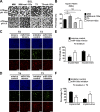Thyroid hormone regulates muscle fiber type conversion via miR-133a1
- PMID: 25512392
- PMCID: PMC4274265
- DOI: 10.1083/jcb.201406068
Thyroid hormone regulates muscle fiber type conversion via miR-133a1
Abstract
It is known that thyroid hormone (TH) is a major determinant of muscle fiber composition, but the molecular mechanism by which it does so remains unclear. Here, we demonstrated that miR-133a1 is a direct target gene of TH in muscle. Intriguingly, miR-133a, which is enriched in fast-twitch muscle, regulates slow-to-fast muscle fiber type conversion by targeting TEA domain family member 1 (TEAD1), a key regulator of slow muscle gene expression. Inhibition of miR-133a in vivo abrogated TH action on muscle fiber type conversion. Moreover, TEAD1 overexpression antagonized the effect of miR-133a as well as TH on muscle fiber type switch. Additionally, we demonstrate that TH negatively regulates the transcription of myosin heavy chain I indirectly via miR-133a/TEAD1. Collectively, we propose that TH inhibits the slow muscle phenotype through a novel epigenetic mechanism involving repression of TEAD1 expression via targeting by miR-133a1. This identification of a TH-regulated microRNA therefore sheds new light on how TH achieves its diverse biological activities.
© 2014 Zhang et al.
Figures








References
-
- Baldwin K.M., and Haddad F.. 2001. Effects of different activity and inactivity paradigms on myosin heavy chain gene expression in striated muscle. J. Appl. Physiol. 90:345–357. - PubMed
Publication types
MeSH terms
Substances
LinkOut - more resources
Full Text Sources
Other Literature Sources
Molecular Biology Databases

